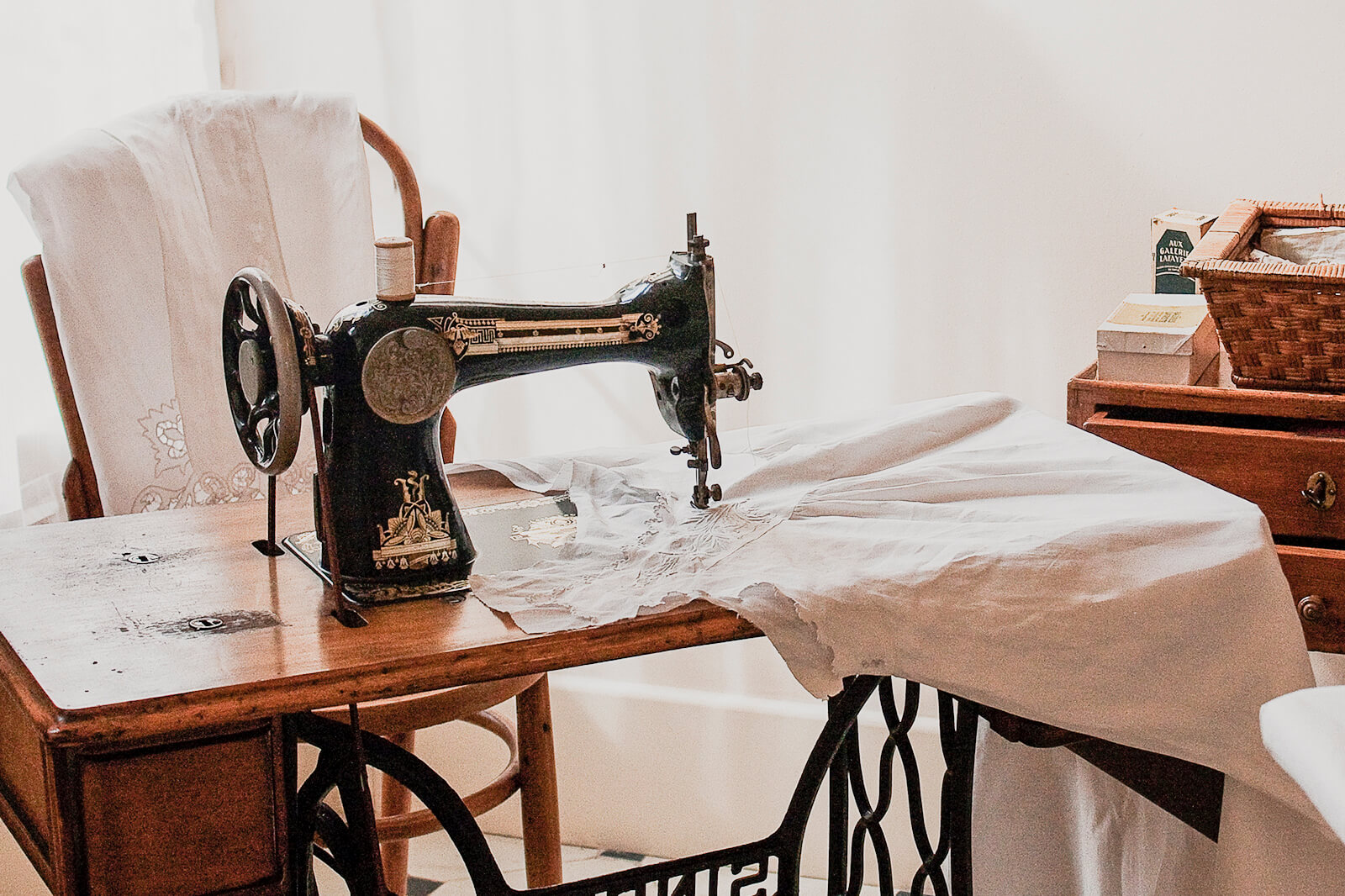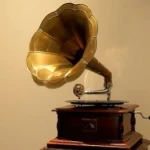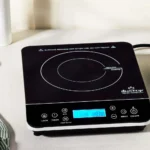
A sewing machine is a mechanical or computerized device used to stitch fabrics and materials together with thread, automating the sewing process. It’s equipped with a needle, bobbin, fabric feed mechanism, and controls for various stitching options. Sewing machines find applications in creating clothing, textiles, quilts, and more, both in domestic and industrial settings, greatly expediting sewing tasks and making them more precise and efficient.
Here are some interesting facts about sewing machines:
In 1790, Thomas Saint, an Englishman, secured a patent for a sewing machine design. This design, however, never progressed beyond the patent stage. Saint’s machine was intended for sewing leather and canvas materials and featured a unique chain stitch mechanism. Although Saint’s invention was ahead of its time, it remained a conceptual blueprint and was never manufactured.
Barthelemy Thimonnier, a French tailor, created a groundbreaking sewing machine in 1830. His machine was capable of sewing straight seams using a chain stitch. This marked a significant step forward in automating the labor-intensive process of hand sewing.
Elias Howe’s 1846 patent represented a major leap in sewing machine technology. His invention featured a lockstitch mechanism, which produced a more secure and reliable stitch than the chain stitch. This innovation laid the foundation for subsequent sewing machine advancements and formed the basis for many modern sewing machines.
Isaac Singer’s contributions to sewing machine history are noteworthy. In 1851, he received a patent for a sewing machine design that incorporated several practical features, such as the foot treadle and presser foot. Singer’s sewing machines became wildly popular and accessible to a broad audience, revolutionizing home sewing and cementing his place in sewing machine history.
Sewing machines initially relied on manual power, either through hand-cranking or foot-operated treadles. The adoption of electric sewing machines gained momentum in the early 20th century. Electric machines offered greater speed, efficiency, and ease of use, marking a significant shift in sewing technology.
In 1893, the sewing machine industry saw a pivotal development with the introduction of the zigzag stitch. This innovation expanded the versatility of sewing machines, enabling both decorative embroidery and more robust stitching. Zigzag stitching became a standard feature on many modern machines.
The stitching speed of a typical domestic sewing machine varies depending on the model and the type of stitching being performed. On average, domestic sewing machines can produce between 500 and 1,500 stitches per minute. Speed capabilities are influenced by factors like motor power and machine design.
Helen Blanchard made sewing more accessible to households with her 1871 invention of the portable sewing machine. Prior to this innovation, sewing machines were often large and immobile, mainly used in factories. Blanchard’s portable machine allowed individuals to sew at home, contributing to the popularity of sewing as a domestic activity.
Industrial sewing machines are designed for high-speed and heavy-duty sewing tasks. They can far surpass the stitching speeds of domestic machines, with some industrial models capable of reaching speeds exceeding 5,000 stitches per minute. This rapid stitching rate is essential for efficient mass production in industries like apparel manufacturing.
In 2017, Andy Phillips achieved a remarkable feat by setting the Guinness World Record for the fastest time to sew a standard buttonhole using a sewing machine. His record-breaking time of 35.40 seconds highlights the precision and speed that skilled sewists can achieve with modern sewing equipment and techniques.
In 1882, Singer built the world’s largest sewing machine, weighing over 40,000 pounds. This colossal machine was used in the construction of sections of the garment for the Statue of Liberty. It symbolizes the significance of sewing machines in historical monuments and large-scale projects.
Amasa B. Wilson patented the bobbin, a small spool that holds the lower thread in a sewing machine, in 1851. The bobbin is a critical component of sewing machines, ensuring the proper interlocking of threads to create stitches.
In 1854, Allen B. Wilson patented the rotary hook mechanism used in many modern sewing machines. This mechanism is responsible for catching the upper thread and looping it with the lower thread to create stitches. It’s a fundamental part of sewing machine technology.
The invention of the overlock machine in the early 20th century revolutionized the production of serged seams. These types of seams are commonly used in clothing manufacturing to prevent fraying and add durability to garments. Overlock machines remain crucial in the fashion industry.
The 1970s saw the introduction of computer-controlled sewing machines, marking a significant leap in automation. These machines could be programmed to perform intricate stitching patterns and embroidery, opening up new possibilities in the world of sewing and design.
Singer was one of the first companies to offer installment payment plans for sewing machines in the 1850s. This financial innovation made sewing machines more affordable to the general public, enabling more households to acquire and use them.
During World War I, sewing machines played a vital role in the war effort. They were adapted for mass-producing military uniforms, tents, and other essential equipment. This contributed significantly to the war production effort.
The first patent for a button-sewing machine was issued in 1864. These machines automated the process of attaching buttons to garments, increasing the efficiency of clothing production.
Sewing machines have been used in space missions to repair fabrics and equipment in zero gravity. The ability to make on-the-spot repairs is crucial in space, where resources are limited, and every item must be conserved.
Garry Louima achieved the Guinness World Record for the longest sewing marathon in 2016, sewing continuously for 103 hours and 46 minutes. This remarkable feat showcases the dedication and endurance of individuals in the sewing community.
The world’s oldest known functional sewing machine was built by Josef Madersperger in the early 19th century. This historic machine is on display at the Vienna Technical Museum, showcasing the early innovations in sewing technology.
The SINGER 160 Limited Edition holds the title of the most expensive sewing machine ever made. In 2011, it was sold for a staggering $26,000. This machine is a testament to the craftsmanship and luxury that can be associated with sewing equipment.
In 2012, a vintage sewing machine dating back to 1880 was sold at auction for an impressive $365,000. This sale highlights the collectible value of antique sewing machines, particularly those with historical significance or unique features.
Sewing machines have been employed in the production of a wide range of products, including clothing, shoes, parachutes, car upholstery, and furniture. Their versatility and precision make them indispensable in various industries.
Sewing machines have played a significant role in empowering individuals and industries alike. By increasing the efficiency and precision of fabric and textile work, sewing machines have contributed to economic development, fashion innovation, and the ability for people to create and repair items with skill and creativity.
Frequently Asked Questions about Sewing Machines:
1. What is a sewing machine?
A sewing machine is a device used to stitch fabric and other materials together using thread. It can be operated manually or electronically, and it automates the process of sewing, making it faster and more efficient compared to hand sewing. Sewing machines come in various types, including mechanical, electronic, and computerized models, each offering different features and functionalities.
2. How do I choose the right sewing machine for beginners?
When selecting a sewing machine for beginners, consider the following factors:
- Ease of Use: Look for machines with user-friendly interfaces and simple controls.
- Features: Basic stitches (straight and zigzag) are essential. Additional features like automatic needle threading and built-in stitches can be helpful.
- Portability: If you plan to move your machine frequently, consider a lightweight model.
- Budget: Set a budget that fits your needs. There are good options available at various price points.
- Brand Reputation: Research brands known for reliability and customer support.
3. What are the different types of sewing machines?
There are several types of sewing machines, including:
- Mechanical Sewing Machines: Operated by a hand crank or foot pedal, these machines are straightforward and reliable.
- Electronic Sewing Machines: Feature electronic controls and can offer more stitch options and functions.
- Computerized Sewing Machines: Equipped with a computer interface, allowing for advanced features like embroidery and programmable stitches.
- Overlock Machines: Designed for finishing edges and seams, these machines are ideal for knit fabrics.
- Quilting Machines: Specifically designed for quilting, often with a larger workspace and specialized feet.
4. How do I maintain my sewing machine?
Regular maintenance is crucial for optimal performance. Here are some tips:
- Clean Regularly: Remove lint and dust from the machine, especially in the bobbin area and feed dogs.
- Oil the Machine: Follow the manufacturer’s instructions for oiling, usually every few projects.
- Check Tension: Ensure the thread tension is set correctly for different types of fabric.
- Use the Right Needles: Change needles regularly and use the appropriate type for your fabric.
- Store Properly: Keep the machine covered when not in use to prevent dust accumulation.
5. What are common sewing machine problems and solutions?
Some common issues include:
- Thread Bunching: This can occur due to incorrect threading or tension settings. Re-thread the machine and check the tension.
- Skipped Stitches: Often caused by a dull needle or incorrect needle type. Change the needle and ensure it is inserted correctly.
- Fabric Not Feeding: Check if the feed dogs are engaged and that the presser foot is down.
- Machine Jamming: Remove the fabric and check for thread tangles or debris in the bobbin area.
6. Can I sew thick fabrics with a regular sewing machine?
Yes, many regular sewing machines can handle thick fabrics, but it’s essential to use the right needle and thread. A heavy-duty needle and thicker thread will help. Additionally, some machines have specific settings or feet designed for thicker materials, so check your machine’s manual for guidance.
7. What accessories do I need for my sewing machine?
Essential accessories include:
- Needles: Various types for different fabrics (universal, ballpoint, etc.).
- Thread: Quality thread that matches your fabric type.
- Presser Feet: Different feet for various sewing techniques (zipper foot, walking foot, etc.).
- Bobbin: Extra bobbins for different thread colors.
- Seam Ripper: For removing stitches.
- Measuring Tools: Rulers, measuring tapes, and marking tools.
8. How do I troubleshoot my sewing machine?
If you encounter problems, start by checking the following:
- Ensure the machine is threaded correctly.
- Check the needle for damage or the wrong type.
- Adjust the tension settings if stitches are uneven.
- Clean the machine to remove dust and lint. If problems persist, consult the manual or seek professional help.
9. Where can I find sewing machine tutorials?
You can find a wealth of tutorials online, including:
- YouTube: Numerous channels offer sewing tutorials for beginners to advanced techniques.
- Sewing Blogs: Many sewing enthusiasts share tips, patterns, and tutorials on their blogs.
- Online Courses: Platforms like Skillshare or Udemy offer structured sewing courses.
10. What is the best way to learn sewing?
The best way to learn sewing is through a combination of practice and education. Here are some suggestions:
- Take a Class: Look for local sewing classes at community centers, fabric stores, or craft shops. In-person instruction can provide hands-on experience and immediate feedback.
- Online Tutorials: Utilize online resources, including video tutorials and step-by-step guides. Websites like YouTube have a vast array of sewing content for all skill levels.
- Practice Regularly: Start with simple projects, such as pillowcases or tote bags, to build your confidence. Gradually progress to more complex items as your skills improve.
- Join a Sewing Group: Connecting with other sewing enthusiasts can provide support, inspiration, and shared knowledge. Look for local sewing clubs or online communities.
- Read Books and Magazines: There are many sewing books and magazines that cover techniques, patterns, and tips for all levels of sewers.









